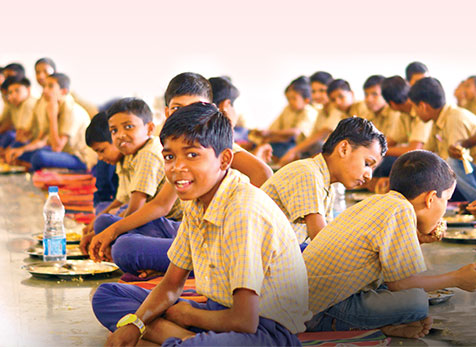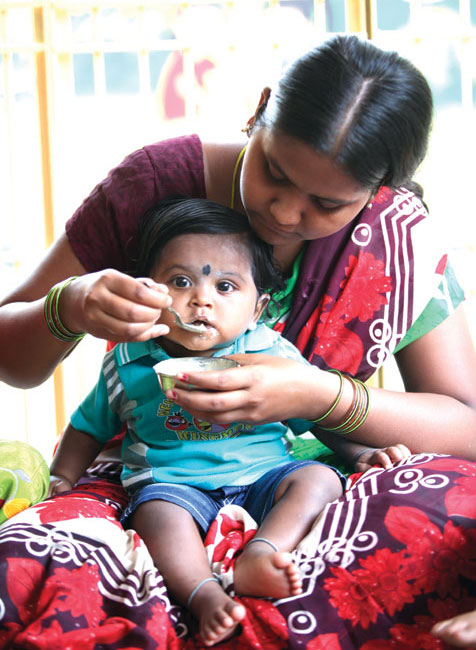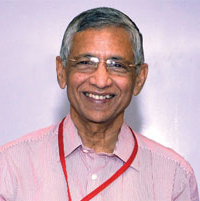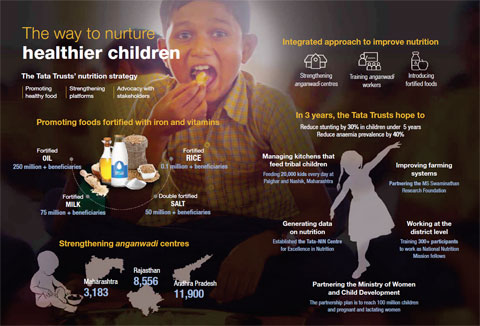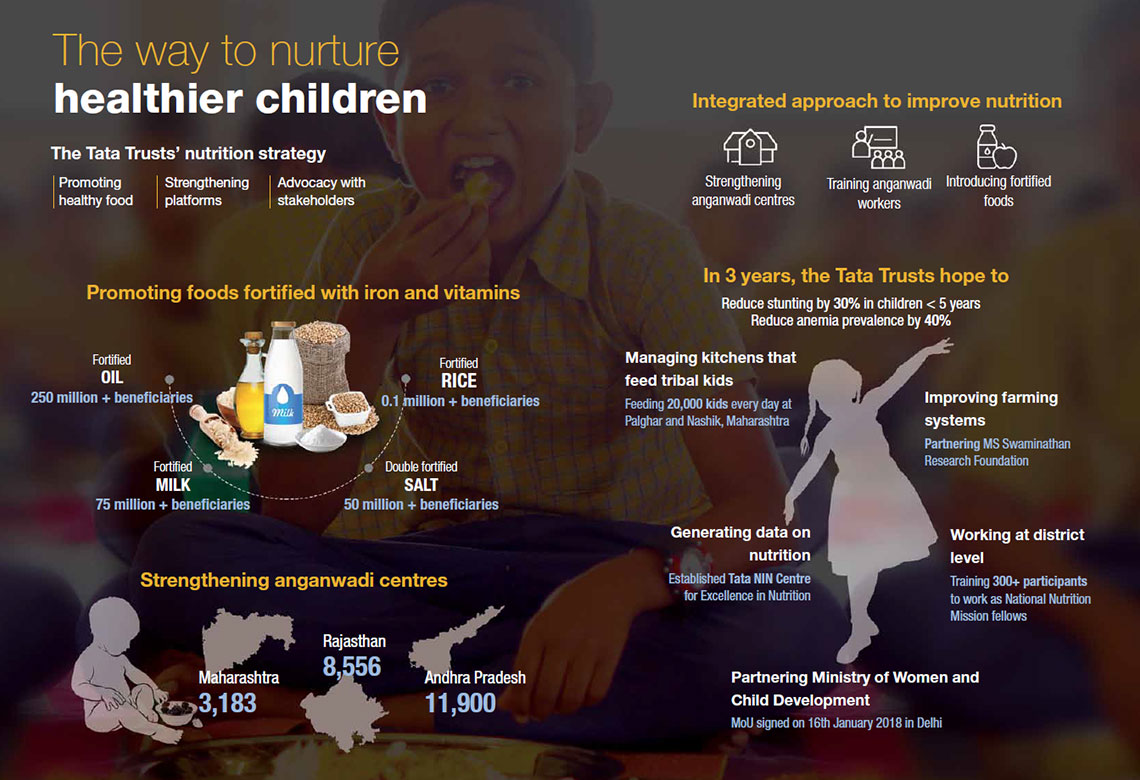Food first
Ensuring that India’s underprivileged children eat healthy — this is the objective driving the Tata Trusts’ nutrition initiative, a multi-pronged effort that covers millions of needy women and their kids
Sarika, six months pregnant, comes every day to the Penumaka anganwadi centre in Guntur in Andhra Pradesh for a hot meal of dal, rice, egg and milk. The meal will increase her nutritional levels so that the child she bears will grow up healthy, not stunted.
Undernutrition continues to be a major challenge in India, with 40% of children below five years of age stunted (short for their age) and 20% of them wasted (low weight).
High rates of undernutrition combined with its huge population base makes India the country with the largest number of malnourished in the world. It is shocking numbers like these that the Tata Trusts are aiming to reduce through its ‘India nutrition initiative’.
The Tata Trusts began partnering the National Nutrition Mission, under the Ministry of Women and Child Development from January 2018. The mission has set a three-year beneficiary target of 100 million children and pregnant and lactating women.
Kicked off in 2017, the mission has been launched in 315 districts (roughly half of India). The Trusts have set their own targets — to reduce the prevalence of stunting in children less than 5 years of age by 30%, and to reduce the prevalence of anaemia (iron deficiency) by 40%. To do this, it intends to reach out to improve nutrition levels for 6 million children and 750,000 pregnant and lactating women.
“We believe that improving nutrition standards will help improve India’s physical and mental health parameters. We aim to impact underprivileged and marginalised communities, and to go beyond urban areas and work in the interiors,” says Dr Rajan Sankar, director of the Trusts’ nutrition initiative.
Multi-sector approach
To achieve this laudable goal, the Tata Trusts are working at several levels. One of their programmes has adopted a multi-sectoral approach to nutrition.
They are partnering the government to strengthen existing platforms; collaborating with agencies to develop staple foods fortified with iron, vitamins, folic acid, etc; working at the grassroots level with beneficiaries; and supporting advocacy partners to generate data that will give a true picture of what India’s undernourished children need to turn the corner. The Trusts also work with civil society organisations, including international NGOs and other development partners.
The most intensive engagement is the partnership with the government. India runs a massive maternal and child health programme called Integrated Child Development Services (ICDS). This programme covers a vast network of over 1.4 million anganwadi centres, which act as support centres for mothers and children upto the age of six.
The centres reach out to 84 million children and 19 million pregnant and lactating mothers, and are monitored by each state government’s department of woman and child services (or its equivalent).
“ICDS reaches millions of beneficiaries, and working with this system should enable us to make a bigger impact,” says Dr Sankar. The Tata Trusts have already signed a memoranda of understanding with three state governments — Maharashtra, Andhra Pradesh and Rajasthan — to strengthen the existing ICDS network.
In Maharashtra’s Palghar district, the Trusts will transform 200 anganwadis into model centres to make them more colourful, appealing and child-friendly. In Andhra Pradesh, the Tata Trusts have stepped in to partner the state government in implementing its nutrition mission across three districts (see linked article). In Rajasthan, the Tata Trusts have adopted a multi-dimensional approach and are working with the ministries of health, water and sanitation, food and agriculture, rural development and women’s welfare to ensure that the ICDS system gets the necessary infrastructural support.
In all three states, the Trusts are working to build better capabilities amongst anganwadi workers through training programmes that will help them bring about behavioural changes in the community. Technology is being brought into play — the Trusts are helping anganwadi workers to use mobile devices that will capture real -time data.
Mission possible
To support the National Nutrition Mission, a new initiative called Swasth Bharat Prerak Programme was kicked off a few months ago. Preraks are interns who will be trained to work with district collectors’ offices to monitor and drive the nutrition mission. At present 112 preraks have been trained and placed in their respective districts; over time, the prerak programme is expected to cover 550 districts.
Malnutrition can be fought by ensuring that the food consumed by children and pregnant mothers has adequate vitamins and minerals. In 2016, the Tata Trusts and the Food Safety and Standards Authority of India (FSSAI) partnered to set up the Food Fortification Resource Centre (FFRC). Advocacy and capacity building is the route that FFRC takes to promote the use of fortified foods.
The five foods being fortified in India are milk, salt, oil, wheat and rice (see linked story). Placing these fortified staple foods into India’s ICDS, school midday meals and the public distribution system will help expand the availability of key nutrients. The Trusts’ target is to provide fortified food to 350 million people within three years, says Dr Sankar.
Sure-fire way
One sure-fire way of ensuring that children get their daily dose of nutritious food is to work directly with the school mid-day meal scheme. The Trusts support organisations such as Akshaya Patra which supply food to millions of children under this scheme.
Two years ago, the Trusts set up two centralised kitchens in Maharashtra’s Palghar and Nashik districts to supply food to children in tribal schools. Managed by the Trusts, the kitchens provide hygienic and nutritious meals thrice a day, and snacks, to 20,000 children.
Advocacy based on data and statistics plays a big role in increasing awareness about India’s multiple nutrition problems, and in getting well-wishers on board. The Tata Trusts have partnered with the National Institute of Nutrition (NIN) to set up a Tata-NIN Centre for Excellence in Nutrition in Hyderabad. The centre provides data-driven insights and advice to state and central governments.
Another institution active in nutrition is the MS Swaminathan Research Foundation (MSSRF) in Chennai, which supports new farming systems as a path to tackle household food and nutrition security in rural India.
Yet another identified need is to find ways to introduce healthy foods in the market. The Trusts have partnered with food giant Mars to create nutritious food products that are both healthy and appealing to children. By manufacturing and distributing such products at scale, the Trusts hope to create a pull, especially in rural markets. A high protein snack is ready for launch.
By adopting this multi-faceted approach to nutritional security and working with stakeholders across India’s food and health ecosystem, the Tata Trusts are working towards achieving large-scale sustainable impact on India’s most vulnerable population — children, who are India’s future.
